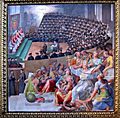Council of Trent facts for kids
The Council of Trent was a very important meeting for the Catholic Church. It was the 19th Ecumenical council, which means a big meeting of church leaders from all over the world. These leaders met in a city called Trento (in modern-day Italy). They met three different times between 1545 and 1563.
The main reason for these meetings was the Protestant Reformation. This was a time when many people, like Martin Luther, started to disagree with some of the Catholic Church's teachings and practices. The Council of Trent was the Catholic Church's way of responding to these new ideas.
During the council, Catholic leaders made their beliefs stronger. They explained their teachings on things like how people are saved, the sacraments (important religious ceremonies), and which books belong in the Bible. They wanted to answer all the questions and disagreements raised by the Protestants.
It was not easy for the council to meet. Sometimes, popes or emperors did not want it to happen. For example, Charles V, Holy Roman Emperor wanted the council, and Pope Paul III tried to start it in 1537, but it didn't work out. The council finally began in 1545, just before Martin Luther died.
The meetings were stopped and started many times. They paused from 1547 to 1551. They met again from 1551 to 1552 but stopped because of a rebellion. Pope Paul IV (1555-1559) strongly disliked Protestant ideas, so the council could not restart during his time. The council met for the last time from 1562 to 1563.
The Council of Trent was a big part of the Counter-Reformation. This was the Catholic Church's effort to reform itself and fight against the spread of Protestantism. After this council, it would be over 300 years until the next major Ecumenical Council.
Pope Paul III saw that the Protestant Reformation was growing fast. At first, only a few priests were involved. But soon, many powerful leaders, especially in Germany, supported these new ideas. Because of this, Pope Paul III really wanted a council. The council was moved to Bologna in 1547 to avoid a sickness. It then stopped meeting until 1551.
Pope Julius III (1550–1555) reopened the council in Trento in 1551. It stopped again in 1552. Finally, Pope Pius IV (1559–1565) called the council back for its last session in 1562. It continued until December 4, 1563.
Contents
Goals and Outcomes of the Council
The Council of Trent had two main goals:
- To stop the spread of Protestantism and to make the Catholic Church's teachings stronger.
- To change parts of the church and actions of church leaders that were causing problems or hurting the church's image.
Here are some of the important outcomes:
- The church's way of understanding the Bible was declared final. Anyone who disagreed with it was called a heretic. Also, the Bible and the Church's traditions were said to have equal importance.
- The council explained how faith and good actions work together for salvation. This was a response to Martin Luther's idea of "justification by faith alone."
- Catholic practices like pilgrimages (holy journeys), honoring saints and holy objects (relics), especially the Virgin Mary, were strongly supported again.
- The selling and buying of false indulgences (pardons for sins) were officially stopped.
The council's decisions were written in two ways. There were "decrees" (decreta), which explained the church's official beliefs. Then there were "canons" (canones), which were short statements that condemned Protestant ideas, often ending with "anathema sit" (meaning "let him be condemned").
Key Decisions Made by the Council
The table below shows some of the important beliefs and practices that the Council of Trent discussed and made rules about.
| Topic | Session | Date | Canons | Decrees |
|---|---|---|---|---|
| On the Symbol of the Faith | 3 | February 4, 1546 | None | 1 |
| The Holy Scriptures | 4 | April 8, 1546 | None | 1 |
| Original sin | 5 | June 7, 1546 | 5 | 4 |
| Justification | 6 | January 13, 1547 | 33 | 16 |
| The Sacraments in General | 7 | March 3, 1547 | 13 | 1 |
| Baptism | 7 | March 3, 1547 | 14 | None |
| Confirmation | 7 | March 3, 1547 | 3 | None |
| Holy Eucharist | 13 | October 11, 1551 | 11 | 8 |
| Penance | 14 | November 15, 1551 | 15 | 15 |
| Extreme Unction | 14 | November 4, 1551 | 4 | 3 |
| Holy Eucharist, On Communion | 21 | June 16, 1562 | 4 | 3 |
| Holy Eucharist, On the Sacrifice of the Mass | 22 | September 9, 1562 | 9 | 4 |
| Holy Orders | 23 | July 15, 1563 | 8 | 3 |
| Matrimony | 24 | November 11, 1563 | 12 | 1 |
| Purgatory | 25 | December 4, 1563 | None | 1 |
| Cults: Saints, Relics, Images | 25 | December 4, 1563 | None | 3 |
| Indulgences | 25 | December 4, 1563 | None | 1 |
Related Pages
Images for kids
See also
 In Spanish: Concilio de Trento para niños
In Spanish: Concilio de Trento para niños




